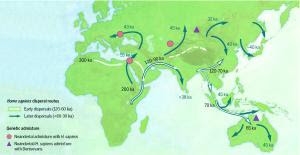By Staff Reports
(Hawaii)– A new study published in the journal Science by researchers from the University of Hawai‘i at Mānoa and the Max Planck Institute for the Science of Human History calls for a re-evaluation of our understanding of when and how humans left Africa and what happened once they arrived in Asia.
Most people are familiar with the traditional Out of Africa model that currently dominates the literature and textbooks. This model theorizes that modern humans evolved in Africa, then dispersed throughout the world in a single wave about 60,000 years ago. Today, technological advances and multidisciplinary research teams have uncovered new data that suggests the picture is much more complicated.
“We are finding that the picture to describe modern human origins is a great deal more complicated than traditionally believed. In fact, we are finding growing evidence that there were likely multiple dispersals out of Africa, some beginning by at least the advent of the Late Pleistocene some 120,000 years ago, and that these Homo sapiens interbred with other hominins, such as Neanderthals and Denisovans, across the globe. This complicates the history of our origins,” said study co-author Christopher J. Bae, professor of anthropology in the College of Social Sciences at UH Mānoa.
The study introduces an accumulation of evidence facilitated by growing interactions between scientists working in different regions of the Asian continent, a situation that has only begun changing over the past decade or so.
The result is a refined picture of human dispersal out of Africa. Recent studies have identified modern H. sapiens remains at multiple sites in China that have been dated to between 70,000 and 120,000 years ago. Additional finds indicate that modern humans reached Southeast Asia and Australia prior to 60,000 years ago.
While other recent studies do confirm that all non-African populations branched off from a single ancestral population in Africa approximately 60,000 years ago, this could indicate that there were multiple, smaller dispersals of humans out of Africa as early as 120,000 years ago, followed by a major dispersal 60,000 years ago.
“The initial dispersals out of Africa prior to 60,000 years ago were likely by small groups of foragers, and at least some of these early dispersals left low-level genetic traces in modern human populations. In other words, not all of these earlier dispersals should be considered to have been evolutionary dead ends. A later, major Out of Africa event most likely occurred around 60,000 years ago or thereafter,” explained co-author Michael Petraglia of the Max Planck Institute for the Science of Human History.
The study also addresses evolutionary questions that have long perplexed the field like whether modern humans replaced the indigenous populations when moving into new regions or if, alternatively, population contact and interbreeding occurred regularly. Today, backed by technological advances that have increased successful collection of ancient DNA from hominin fossils, researchers are finding evidence of interbreeding on a somewhat regular basis. Modern humans interbred not only with Neanderthals, but also with our recently-discovered relatives the Denisovans, as well as a currently unidentified population of pre-modern hominins.
One estimate is that all present-day non-Africans have 1-4 percent Neanderthal heritage, while another group has estimated that modern Melanesians have an average of 5 percent Denisovan heritage. In all, it is now clear that modern humans, Neanderthals, Denisovans and perhaps other hominin groups all likely overlapped in time and space in Asia, and they certainly had many instances of interaction.
The researchers also shed light on the culture of humans and ancient hominins. It was previously thought that only modern humans could produce complex stone tools or use objects for symbolic purposes, such as for ornamentation. Whenever such objects were found, it was assumed that they were created by modern humans. This was the case at Denisova Cave, where a set of perforated teeth and ostrich eggshell and bone pendants were found. However, once the hominin remains were subjected to ancient DNA analysis, it was discovered that these artifacts might be associated with Denisovans and/or Neanderthals, not modern humans.
“This suggests that either Denisovans and/or Neanderthals left these ornaments or Denisova Cave has a very complicated occupational history where modern humans, Denisovans, and Neanderthals stayed there at one time or another,” explained Bae.
In light of these new discoveries, our understanding of human movements around the globe has become much more complex, and there are still many questions left to be answered. The authors argue for the development of more complicated models of human dispersals and for conducting more research in the many areas of Asia where none has been done to date. Additionally, it will be important to review materials collected prior to the development of modern analytic methods, to see what more can now be learned from them.
“Fortunately, there have been an increasing number of multidisciplinary research programs launched in Asia over the past few decades. The information that is being reported is helping to fill in the gaps in the evolutionary records,” stated co-author Katerina Douka, also of the Max Planck Institute for the Science of Human History.
“It is an exciting time to be involved with paleoanthropological interdisciplinary research projects across Asia,” added Bae.

